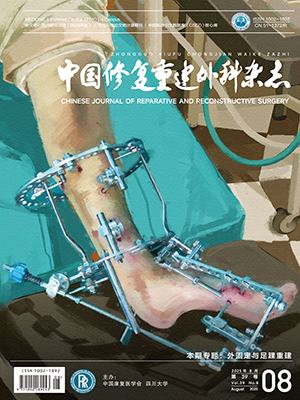Objective To evaluate surgical results of the titanium screwplate internal fixation in treatment of the lower cervical fracture dislocation. Methods From September 2001 to March 2006, 31 patients(24 males, 7 females; age range, 2063 years) with the lower cervical fracturedislocation were treated in our department. The injuries were caused by a road accident in 25 patients, a high crash in 4, and a heavy object crash in 2. The fracture dislocation occurred in the following cervical segments:C3(1 patient),C4(5 patients), C5(12 patients), C6(10 patients), and C7(3 patients). The disease course ranged from 1 to 23 days. The associated spinal nerve root injury occurred in 29 patients. The Frankle scaling revealed that 14 patients were at Grade A, 3 at Grade B, 7 at Grade C, 3 at Grade D, and 2 at Grade E (associated nerve root injury with hand and shoulder numbness). The 29 patients underwentthe spinal cord decompression, the grafting fusion of the small joints, and thelateral mass titanium screwplate internal fixation; 2 patients without nerve injury underwent only the grafting fusion of the small joints and the lateral mass titanium screwplate internal fixation. The bone fusion, cervical vertebra movement, and internal fixation condition were observed by the X-ray examinations postoperatively. The nerve function recovery was evaluated by the Frankle scaling system. Results The followedup in all the patients for 6months to 4 years revealed that the small joint fusion time was 36 months, with an average of 3.6 months. The cervical X-ray films showed that there was no instability or fracture looseness of the internal fixation at 6 months. Among the 29 patients with the spinal nerve root injury, 14 were at Grade A preoperatively but 13 were improved at Grade B and 1 at Grade C postoperatively; 3 were at Grade B preoperatively but 2 were improved at Grade C and 1 at Grade D postoperatively; 7 were at Grade C preoperatively but 3 were improved at Grade D and 4 at Grade E postoperatively; 3 at Grade D preoperatively but all the 3 were improvedat Grade E postoperatively; 2 were at Grade E preoperatively and remained unchanged postoperatively. In the 2 patients with only the nerve root injury, numbness disappeared soon after operation. Conclusion This posteriorapproach has two advantages: the mobility range of the cervical vertebra can preserved to the greatest extent because of the short segment fixation; the betterstability can obtained because of the titanium screwplate internal fixation on the cervical jointcolumn to prevent the hyperextension and hyperflexion. Therefore, the titanium screwplate internal fixation on the cervical lateral massis an effective treatment of the lower cervical fracture dislocation.
Citation: ZHANG Xin,HE Mushun,ZHANG Zhankui,et al.. TREATMENT OF LOWER CERVICAL FRACTURE DISLOCATION BY TITANIUM SCREW-PLATE INTERNAL FIXATION ON CERVICAL LATERAL MASS. Chinese Journal of Reparative and Reconstructive Surgery, 2007, 21(4): 374-377. doi: Copy
Copyright © the editorial department of Chinese Journal of Reparative and Reconstructive Surgery of West China Medical Publisher. All rights reserved




